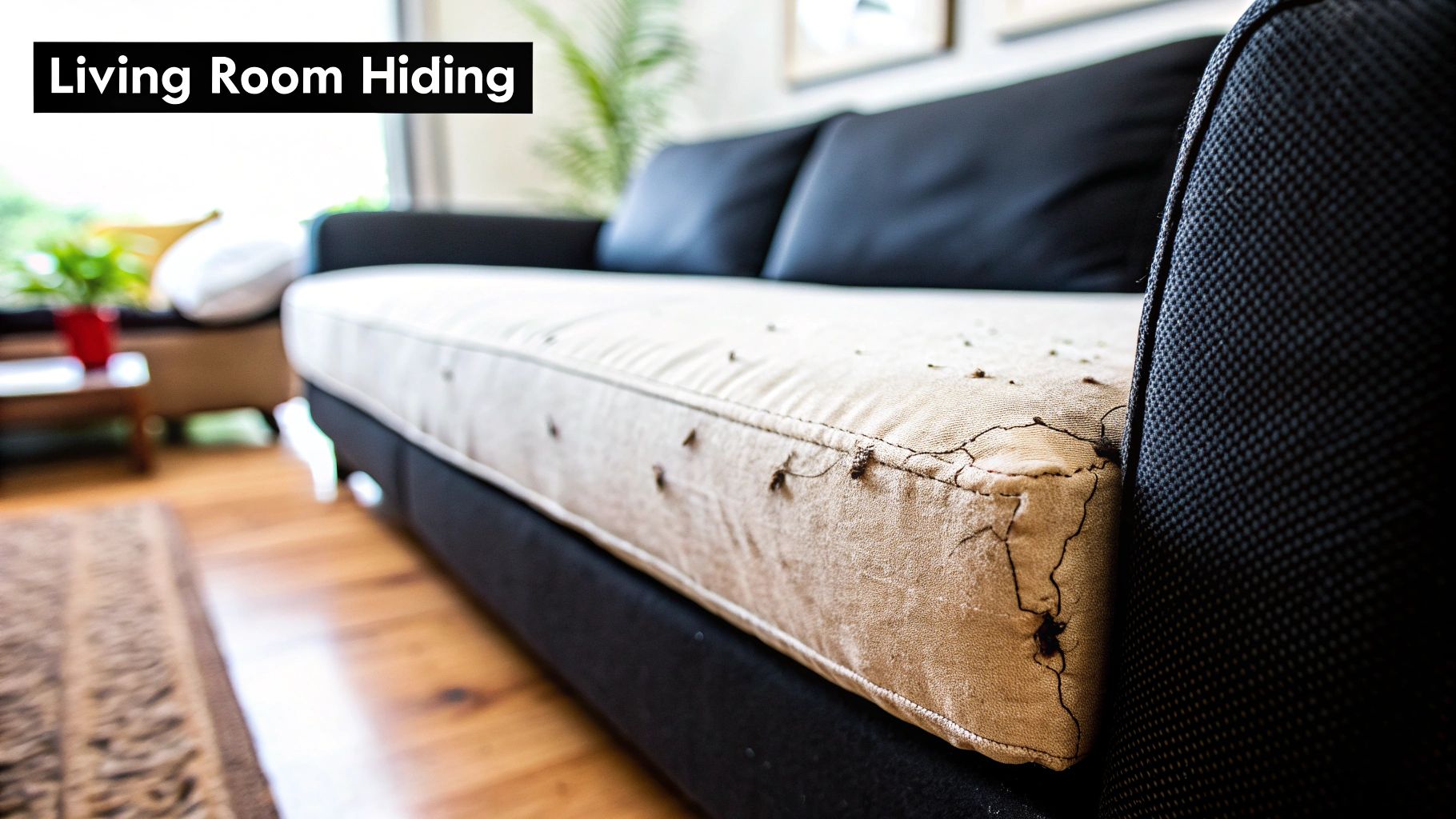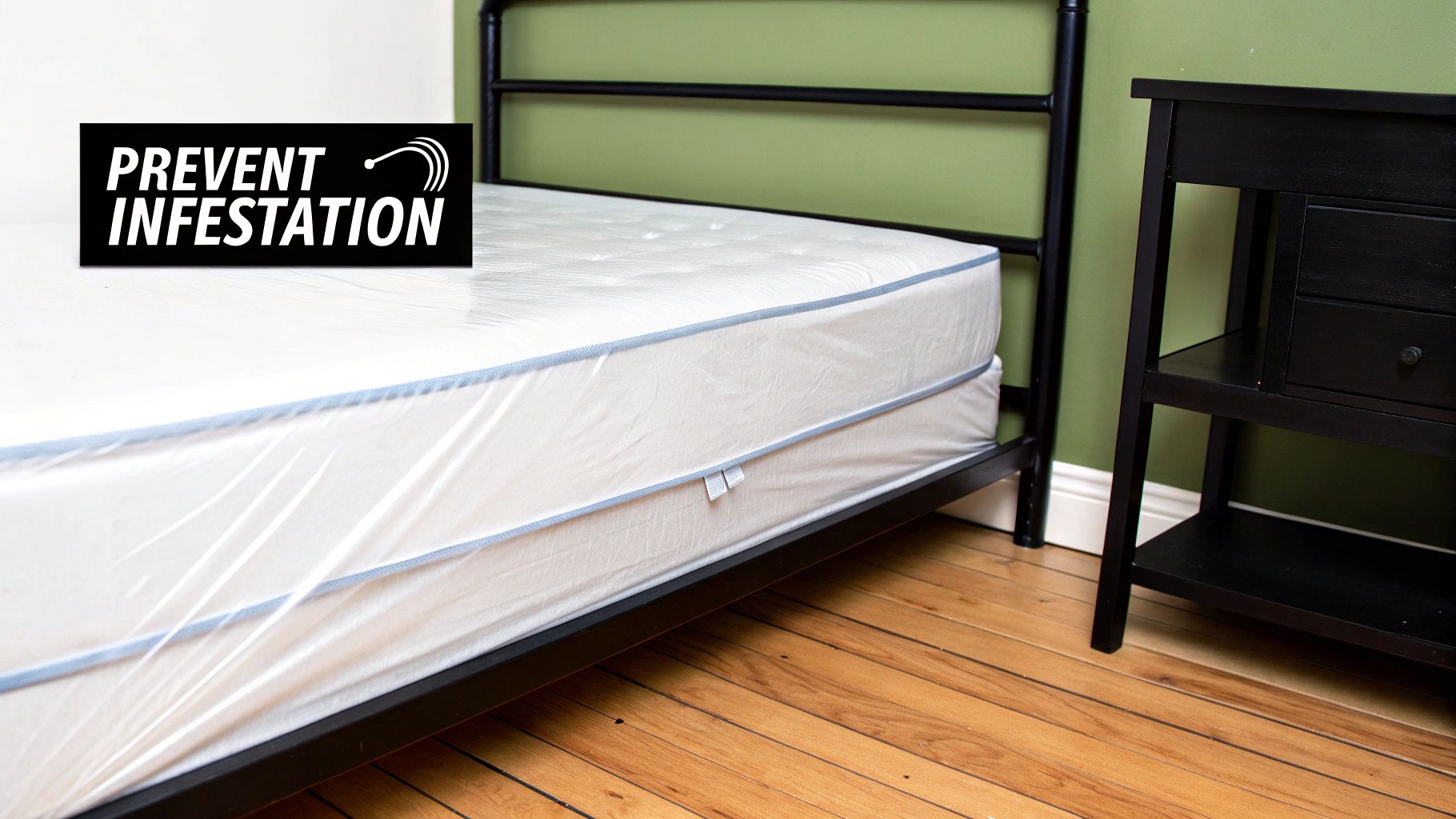
If you want to find where bed bugs are living, you have to start thinking like one. They are expert survivors, and their entire existence is focused on one thing: staying close to their next meal. That makes your bed Ground Zero for any inspection.
Bed Bug Hotspots: The 8-Foot Radius
Think of bed bugs as tiny, unwanted roommates who set up camp within an 8-foot radius of where you sleep. This area is their prime real estate—what we call a "harborage"—and it’s always where you should start looking. They pick these spots because they're dark, secluded, and give them an easy commute to you.
Since they rely completely on human blood to survive, they've adapted to live in places that offer warmth, shelter, and easy access to people. This is exactly why our homes, and especially our bedrooms, are their favorite places to be. You can get a deeper look into why they pick these spots from these insights on bed bug behavior.
To help you prioritize your search, I've broken down their favorite hiding spots into three zones, starting with the most critical areas closest to you.
Bed Bug Hotspots Ranked by Proximity to Host
| Priority Zone | Common Hiding Spots | Why They Hide Here |
|---|---|---|
| Zone 1: The Bed | Mattress seams, box spring, bed frame, headboard | This is the closest they can get to their food source (you). It provides countless dark, tight spaces to hide between feedings. |
| Zone 2: Near the Bed | Nightstands, baseboards, carpet edges, electrical outlets | These spots are within that crucial 8-foot radius, offering safe harbor with a short walk to the bed. |
| Zone 3: The Wider Room | Upholstered furniture, curtains, wall hangings, clothing piles | As an infestation grows, they are forced to expand their territory. These spots are less common but become likely in severe cases. |
This table gives you a clear roadmap for your inspection. Always start with Zone 1 and work your way out.
The Bed Itself: Their Primary Habitat
Your bed is the absolute first and most critical place to inspect. Bed bugs are true masters of stealth, using their flat bodies to squeeze into the tiniest cracks you can imagine.
Start your inspection with these key areas:
- Mattress and Box Spring Seams: Run your fingers slowly along the piping, seams, and tufts of your mattress and box spring. Pay special attention to fabric folds and any tags—these are classic bed bug hideouts.
- Bed Frame and Headboard: Check every joint, screw hole, and crack in the bed frame and headboard. If your headboard is mounted to the wall, don't forget to inspect the gap behind it.

It’s a mistake to think bed bugs are just on the bedding. They colonize the entire structure.
You have to see the bed frame as the foundation of their hidden little city.
By knowing exactly where to look first, you can build a mental map of their likely territories. This is the knowledge that empowers you to spot an infestation before it gets out of control.
Beyond the Bed: Your Bedroom's Hidden Sanctuaries
When a bed bug problem really takes hold, it starts to look like a city bursting at the seams. The mattress is prime real estate, but as the population explodes, competition for space forces them to look for new homes.
Think of it like this: the bed is downtown. Once it gets too crowded, the bugs start building suburbs in any nearby spot. They aren't fussy—any dark, tight crack or crevice will do. Finding them in these other locations is a sure sign you're dealing with a well-established infestation.
Exploring Their Secondary Hideouts
Once they're pushed off the bed, bed bugs will colonize almost anything that offers them shelter. You have to think beyond the mattress and expand your search to these common secondary hiding spots:
- Nightstands and Dressers: They love to tuck themselves into drawer joints, behind the back panels, and even underneath the entire piece of furniture.
- Upholstered Chairs and Sofas: Any fabric-covered furniture in your bedroom has the same cozy seams and tufts as a mattress, making it a perfect new home.
- Behind Wall Hangings: The dark, undisturbed space behind picture frames, clocks, and posters is an ideal spot for a hidden outpost.
- Walls and Baseboards: Peeling wallpaper, cracks in plaster, and the tiny gap between the baseboard and the floor are all potential havens.
A proper inspection is a bit like detective work. Your flashlight is your best friend, and a simple credit card can be the perfect tool for getting into tight crevices where bugs might be hiding.
Try sliding a thin card along the top of your baseboards or into the joints of a nightstand. This simple action can be enough to flush out hidden bugs or at least reveal the dark spots and shed skins they leave behind. This kind of room-wide search is the only way to grasp the true scale of the problem you're facing.
For more in-depth pest management strategies and information, you can explore the various topics we cover on the Kob Medicin Online blog. Taking a comprehensive approach is absolutely key to reclaiming your space.
How Bed Bugs Take Over Your Living Room Furniture

It’s a common mistake to think bed bugs only live in bedrooms. The truth is, these pests are opportunists, and they'll happily set up shop wherever their food source—you—spends a lot of time resting. Your comfy living room couch or your favorite recliner can quickly become the next hotspot for an infestation, especially if you like to nap there.
Bed bugs are simple creatures. They’re drawn to our body heat and the carbon dioxide we breathe out, which means any spot where you're stationary for a while is a prime target. From a bed bug's perspective, your sofa is just as good as a mattress. It offers all the same dark, tight spaces to hide in.
Taking a nap on the couch is basically rolling out the welcome mat. All it takes is a single bug hitching a ride on your clothes to hop off and start a brand new colony. This is what we call a satellite population, and it’s how an infestation explodes from one room into the rest of the house, making it much tougher to get under control.
Inspecting Sofas and Chairs
To figure out if bed bugs have moved into your living room, you’ll need to do a thorough check of all your upholstered furniture. It’s the same detailed process you’d use for inspecting a bed.
First, take off all the cushions and pillows. From there, you'll want to inspect every inch:
- Seams and Piping: Run your fingers and a flashlight along the fabric seams on the cushions and the furniture frame. These tight grooves are classic bed bug hiding places.
- Tufts and Folds: Pay close attention to any decorative buttons, tufts, or deep folds in the fabric. These create perfect little protected pockets for bed bugs to cluster in.
- The Underside and Frame: If you can, flip the entire piece of furniture over. You need to check the wooden or metal frame, especially where joints meet, as well as screw holes and the dust cover on the bottom for any signs of bed bug life.
A satellite population in the living room is a classic example of a bed bug’s survival instinct: simply follow the food. An infested couch becomes a new epicenter, giving them a base to spread throughout your home.
The Secret Travels of Bed Bug Hitchhikers

Bed bugs don't magically materialize in your bedroom. They are master hitchhikers, catching a ride from one place to another and turning a small problem somewhere else into a major headache for you. Knowing how they move is just as crucial as knowing where they hide.
Think of them as tiny, unwanted stowaways. They can't fly or jump, but they are surprisingly quick crawlers. They’ll happily burrow into your personal belongings to find their next meal source—you. This shifts the battleground from simply treating an existing infestation to actively preventing them from getting inside in the first place.
Common Ways Bed Bugs Get Around
These pests are experts in stealth and can wedge themselves into an unbelievable variety of items. They couldn't care less if something is clean or dirty; all they want is a dark, secluded spot to hide until they reach their destination.
Here are the most common ways they travel:
- Luggage and Backpacks: This is the number one way bed bugs spread, especially from hotels, motels, and holiday rentals.
- Secondhand Furniture: That "great deal" you found on a used couch or mattress can come with a very expensive, and very itchy, secret.
- Clothing and Personal Items: They can grab onto the fabric of a coat, a purse, or even the spine of a library book.
The global spread of these pests is a testament to how good they are at traveling. It's a massive problem; the bed bug control market was valued at $1.23 billion USD in 2021 and is expected to hit $1.63 billion USD by 2025. This growth is fueled by infestations spreading through homes and hotels worldwide, thanks to increased travel and trade. You can learn more about the economic impact of bed bugs and see just how big this issue really is.
The single most effective way to prevent a home infestation is to stop these hitchhikers at the door. Your post-travel routine is your first and best line of defense.
When you get back from any trip, take your luggage straight to the garage or laundry room—don't even bring it into the bedroom. Unpack right there and wash everything, even clothes you didn't wear, in hot water. Follow that with a cycle in the dryer on high heat. It’s a simple step, but it’s the most critical one for killing any unwelcome travelers before they have a chance to move in.
Decoding the Telltale Signs of a Bed Bug Habitat
Knowing where bed bugs like to live is one thing, but knowing how to spot the trail they leave behind is what really matters. You have to put on your detective hat and start looking for the clues that give them away. It's a bit like a crime scene investigation—the evidence is subtle, but it's there if you know what to look for.
These aren't always obvious signs, mind you. At first glance, you might dismiss them as specks of dirt. But once you’re trained to see them, the clues become unmistakable. This is how you move from a nagging suspicion to a confirmed problem, letting you take action before things get out of hand.
The Key Pieces of Evidence
The most common signs of a bed bug hideout are easy to miss. The absolute number one piece of evidence is their fecal matter. These are tiny, rust-colored or black spots that look almost like someone took a fine-tipped marker and dotted the fabric.
Those little spots are digested blood. Because the droppings are liquid, they soak right into fabrics like bed sheets, mattress seams, and box springs, leaving a stain that won’t just wipe away.
Another dead giveaway is their shed skin. As bed bugs grow from one stage to the next, they molt, leaving behind their old exoskeletons. These look like perfect, see-through versions of the bugs themselves—pale yellow, hollow, and very brittle. Finding a collection of these casings in cracks, crevices, or along the piping of a mattress is a sure sign you're dealing with an active, growing population. For a better look at what these signs look like in real life, check out some common bed bug FAQs, which often have helpful pictures.
That weirdly sweet, musty smell you hear about with heavy infestations? It’s a mix of the alarm pheromones the bugs release when disturbed and the smell of their droppings. Some people say it smells like old, wet towels or even coriander.
And finally, if you see their eggs, it's game over—you have an infestation. The eggs are incredibly small, about the size of a pinhead, and have a pearly-white color. Finding just one of these signs is cause for concern, but when you start piecing them together, you get the full picture of what you're up against.
To make it easier, here's a quick reference guide to help you identify the visual clues bed bugs leave in their wake.
Visual Evidence of a Bed Bug Infestation
| Type of Evidence | Appearance | Where It's Typically Found |
|---|---|---|
| Fecal Spots | Small, dark brown or black specks; look like ink dots. | Mattress seams, box springs, headboards, bed frames. |
| Shed Skins | Pale, translucent exoskeletons; look like hollow bed bugs. | Crevices, tufts of mattresses, along baseboards. |
| Live Bugs | Small, reddish-brown, flat, oval-shaped insects. | Cracks in furniture, behind wallpaper, in electrical outlets. |
| Eggs | Tiny (1mm), pearly-white, and often found in clusters. | Tucked into fabric seams, wood cracks, and screw holes. |
Keep this table handy as you inspect your home. Spotting even one of these signs means it's time to investigate further.
Common Questions About Bed Bug Habits

Once you start learning where bed bugs live, it's natural for a bunch of other questions to pop up about their strange behaviors. Let's dig into some of the most common things people ask, clearing up a few myths along the way so you can truly understand what you're up against.
A big one is whether these pests actually live on people or pets. The answer is a hard no. Unlike fleas or ticks, bed bugs don't use a living host as their home.
Think of them more like tiny, secretive vampires. They only creep out from their hiding spots for a quick meal, which takes just a few minutes, before scurrying back to a safe crack or crevice. Your bed is their base of operations; you're just the restaurant.
Do Bed Bugs Only Live in Beds?
This is probably the biggest misconception out there, and the name "bed bug" doesn't help. While your bed is definitely their prime real estate—it's right next to their food source, after all—it's far from the only place you'll find them. As an infestation gets bigger, they start branching out to any spot that offers protection.
This includes places you might never think to check:
- Couches and other upholstered furniture
- Tucked behind picture frames on the wall
- Inside electrical outlet covers
- Along the edges of carpets and baseboards
Basically, if a credit card can slip into the gap, a bed bug can hide there. That's why a proper inspection has to go way beyond just the mattress.
A critical mistake homeowners make is thinking a clean house is a protected house. Bed bugs couldn't care less about dirt or grime; they're drawn to warmth, the carbon dioxide you breathe out, and a sleeping host. A spotless home is just as vulnerable as a cluttered one if a single bug hitches a ride inside.
How Far Do Bed Bugs Travel?
While they'd prefer to stay close to the buffet, bed bugs are surprisingly mobile when they need to be. Most of the time, they stick within an 8-foot radius of where a person sleeps. But if that food source disappears, they have no problem traveling to find a new one.
In fact, some studies have shown they can move 20 feet or even more in a single night if they're hungry. In apartments, they can even migrate between units by following plumbing and electrical lines inside the walls. This ability to travel is a huge reason why infestations can spread so fast and why getting a handle on their habits is so important. The team of experts at Kob Medicin Online constantly highlights how crucial understanding pest behavior is for effective control.
